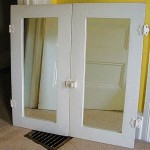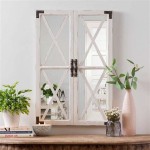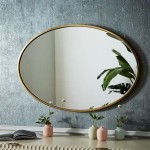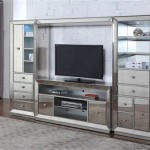How To Make A Mirror Mosaic With Broken Mirrors
Mirror mosaics offer a creative and visually stunning way to repurpose broken mirrors, transforming discarded fragments into captivating art pieces. The process involves carefully adhering mirror shards to a chosen surface, creating an intricate and reflective design. This article provides a comprehensive guide on how to create a mirror mosaic using broken mirrors, encompassing preparation, safety precautions, and step-by-step instructions.
Gathering Materials and Tools
Before embarking on the mirror mosaic project, it is essential to assemble all the necessary materials and tools. This ensures a smooth and efficient workflow, minimizing interruptions and maximizing the creative process. The following list outlines the required components:
* Broken Mirrors: Source broken mirrors from various locations such as thrift stores, recycling centers, or personal collections. Ensure the mirrors are thoroughly cleaned and free of any debris or sharp edges. Different thicknesses and types of mirror glass can add visual interest to the mosaic. * Substrate: A suitable substrate is crucial for providing a stable foundation for the mirror mosaic. Options include wood panels, MDF boards, ceramic tiles, glass surfaces, or even furniture pieces. The choice of substrate depends on the desired size, shape, and application of the finished mosaic. * Adhesive: Selecting the appropriate adhesive is critical for ensuring a strong and durable bond between the mirror shards and the substrate. Mirror adhesive, specifically designed for adhering mirrors to various surfaces, is highly recommended. Construction adhesive or silicone sealant can also be used, ensuring they are compatible with both mirror and substrate. * Grout: Grout fills the gaps between the mirror pieces, providing a finished and cohesive look. Choose a grout color that complements the mirror shards and the overall design aesthetic. Sanded grout is generally preferred for larger gaps, while unsanded grout is suitable for smaller gaps. * Safety Glasses: Safety glasses are indispensable for protecting the eyes from flying shards of glass during the breaking and handling process. Always wear safety glasses when working with broken mirrors. * Gloves: Heavy-duty gloves are essential for protecting the hands from cuts and abrasions while handling broken mirrors. Leather gloves or cut-resistant gloves are ideal for this purpose. * Tile Nipper/Glass Cutter: A tile nipper or glass cutter is used to shape and refine the mirror shards, allowing for precise placement and intricate designs. * Hammer and Old Cloth: A hammer and old cloth are used for safely breaking the mirrors into smaller pieces. Place the mirror between the folds of the cloth and gently tap it with the hammer to create controlled breaks. * Spreader/Trowel: A spreader or trowel is used to apply the adhesive evenly to the substrate and to spread the grout into the gaps between the mirror pieces. * Grout Sponge: A grout sponge is used to clean excess grout from the surface of the mirror mosaic, revealing the reflective beauty of the glass. * Soft Cloth: A soft cloth is used for buffing and polishing the finished mirror mosaic, enhancing its shine and removing any remaining grout residue. * Pencil or Marker: A pencil or marker is used for sketching the desired design onto the substrate before applying the mirror shards. * Ruler or Measuring Tape: A ruler or measuring tape is used for accurate measurements and precise placement of the mirror shards. * Bucket or Container: A bucket or container is needed for mixing the grout according to the manufacturer's instructions. * Water: Water is used for mixing the grout and for cleaning the grout sponge. * Ventilated Workspace: Working in a well-ventilated area is crucial when using adhesives and grouts, as these materials can release fumes that may be harmful if inhaled.Preparing the Mirrors and Substrate
Proper preparation of both the mirrors and the substrate is paramount for achieving a successful and aesthetically pleasing mirror mosaic. This stage involves cleaning, breaking, and shaping the mirrors, as well as preparing the substrate for optimal adhesion.
* Cleaning the Mirrors: Thoroughly clean all the broken mirror pieces using a glass cleaner and a soft cloth. Remove any dirt, dust, or fingerprints that may impede adhesion or detract from the finished appearance. * Breaking the Mirrors: If the mirror shards are too large, carefully break them into smaller, more manageable pieces. Place the mirror between the folds of an old cloth and gently tap it with a hammer. Avoid applying excessive force, as this can result in shattered pieces and potential injury. Exercise caution and wear safety glasses and gloves during this process. * Shaping the Mirrors: Use a tile nipper or glass cutter to shape and refine the mirror shards according to the desired design. This allows for precise placement and intricate patterns. Practice using the tools on scrap pieces of mirror to develop proficiency before working on the main project. * Preparing the Substrate: Ensure the substrate is clean, dry, and free of any loose particles or debris. If using a wooden substrate, lightly sand the surface to create a better bond for the adhesive. If using a porous substrate, such as ceramic or unsealed wood, apply a sealant to prevent the adhesive from being absorbed into the material. * Sketching the Design: Before applying the mirror shards, sketch the desired design onto the substrate using a pencil or marker. This provides a visual guide for placement and helps ensure a cohesive and balanced composition. Consider the overall shape, pattern, and color distribution when planning the design.Applying the Mirrors and Grouting
The application of the mirror shards and the grouting process are the core components of creating a mirror mosaic. These steps require patience, precision, and attention to detail to achieve a visually stunning and durable finished product.
* Applying the Adhesive: Apply a thin, even layer of mirror adhesive to the back of each mirror shard. Avoid using excessive adhesive, as this can cause the mirror pieces to slide or shift during the drying process. * Placing the Mirrors: Carefully place the mirror shards onto the substrate according to the sketched design. Press each piece firmly into the adhesive, ensuring a secure bond. Maintain consistent spacing between the mirror pieces to create a uniform grout line. * Allowing the Adhesive to Dry: Allow the adhesive to dry completely according to the manufacturer's instructions. This may take several hours or even overnight, depending on the type of adhesive used and the ambient temperature and humidity. Avoid disturbing the mirror mosaic during this period to prevent the pieces from shifting or detaching. * Mixing the Grout: Mix the grout according to the manufacturer's instructions. Add water gradually to the grout powder, stirring continuously until a smooth, creamy consistency is achieved. Avoid adding too much water, as this can weaken the grout and make it more prone to cracking. * Applying the Grout: Using a spreader or trowel, apply the grout to the surface of the mirror mosaic, pressing it firmly into the gaps between the mirror pieces. Ensure all the gaps are completely filled with grout. * Removing Excess Grout: After allowing the grout to set for a few minutes, use a damp grout sponge to remove excess grout from the surface of the mirror shards. Rinse the sponge frequently to prevent the grout from hardening on the sponge. * Cleaning the Surface: Continue cleaning the surface with the damp grout sponge until all the excess grout is removed and the mirror shards are clean and visible. Pay particular attention to the edges of the mirror pieces, ensuring they are free of grout residue. * Allowing the Grout to Cure: Allow the grout to cure completely according to the manufacturer's instructions. This may take several days, depending on the type of grout used and the ambient temperature and humidity. * Buffing the Surface: Once the grout is fully cured, use a soft cloth to buff and polish the surface of the mirror mosaic, removing any remaining grout residue and enhancing its shine.By following these detailed instructions and adhering to safety precautions, one can transform broken mirrors into stunning works of art, adding a touch of sparkle and reflection to any space. The possibilities for design and application are virtually limitless, allowing one to express creativity and ingenuity through the art of mirror mosaic.

Diy Mirror Mosaic Wall Art Glam Decor Broken

Diy Mirror Mosaic Wall Art Glam Decor Broken

Diy Mirror Mosaic Art Wall Decor From Broken Tutorial Unique Festive Ideas

Diy Mirrored Mosaic Wall Art Decor Easy

Diy Project Mirror Mosaic Art Smashinbeauty

Turn A Broken Mirror Into Art Instead Of Throwing It Away

Diy Mirror Mosaic Wall Art Petalisbless

20 Brilliantly Crafty Diy Ideas To Upcycle Broken Mirrors

Diy Mirror Mosaic Wall Hangings Holeh Pocket

Sunburst Mosaic Mirror Broken Shards By Frenchdecorevamped I Like The Accents Of Color







